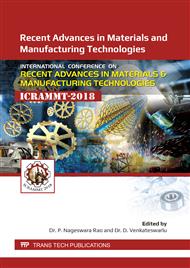p.524
p.530
p.539
p.546
p.552
p.558
p.565
p.570
p.576
Prediction and Optimization of Deformations in Coupling Mechanism Based Laser Forming of Sheet Metals
Abstract:
Fabricating three dimensional shaped surfaces from flat sheet metals by laser forming, both out-of-plane and in-plane deformations are required. This article presents the modeling of coupling mechanism activated laser forming of sheet metals based on experimental data for prediction and optimization of bending and thickening deformations. Experiments were performed based on a central composite design of experiments on coupling mechanism based laser metal forming process considering the input process parameters like laser power, scan speed and spot diameter, bending and thickening were taken as the outputs. Neural network and neuro-fuzzy system-based models were developed to carry out both forward and inverse modeling of the laser metal forming process under the coupling mechanism. Multi-objective optimization based on the non-dominated sorting genetic algorithm was used to obtain multiple optimal solutions to achieve different amounts of out-of-plane and in-plane deformations. The proposed method could guide for a suitable selection of the process parameters to produce three-dimensional shapes utilizing coupling mechanism-based laser forming using multiple laser line heating.
Info:
Periodical:
Pages:
552-557
Citation:
Online since:
August 2019
Authors:
Price:
Сopyright:
© 2019 Trans Tech Publications Ltd. All Rights Reserved
Share:
Citation:


